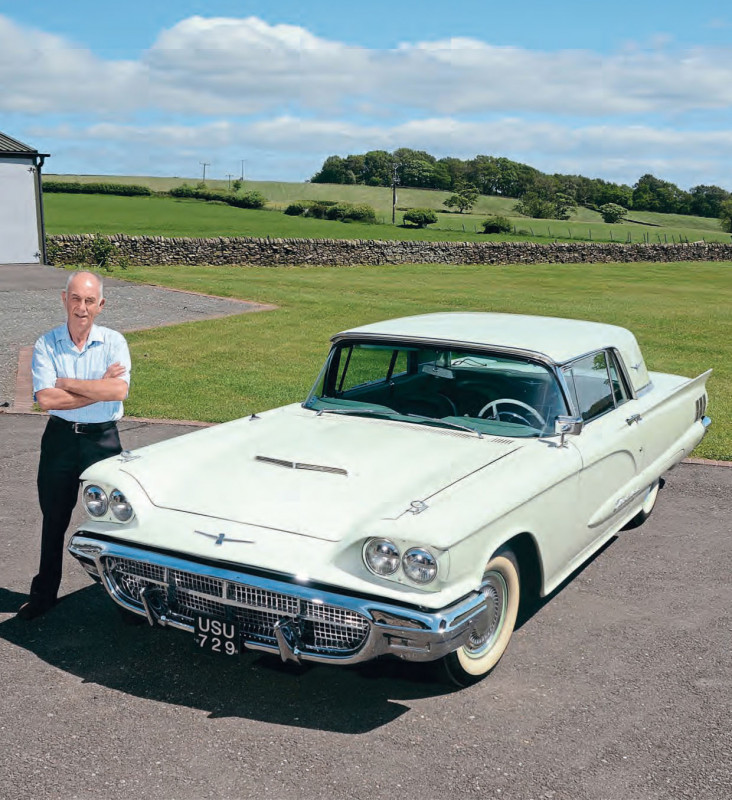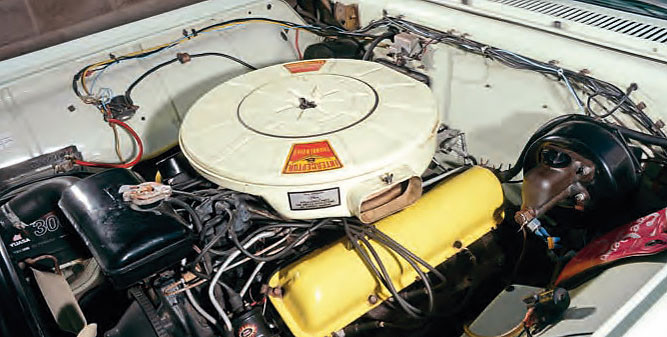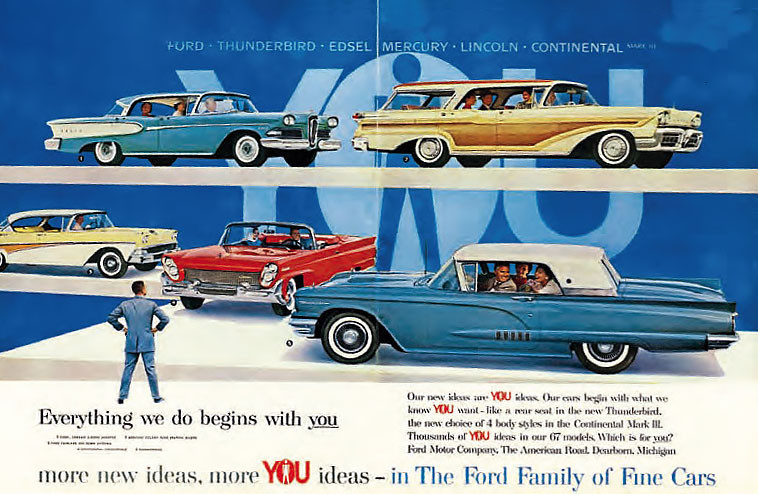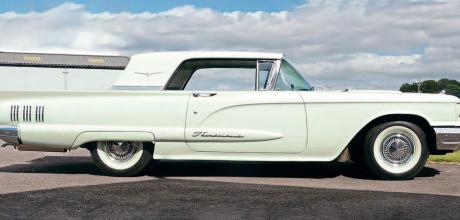Preserved, not restored 1960 Ford Thunderbird
John Thorpe spent years searching for a second-generation Ford Thunderbird without success. But once he’d clapped eyes on this stunning unrestored 1960 example in Adriatic Green, he knew impulsively it was the right car for him…
Words and photography: Jon Cass

Unusually, John’s fascination with American automobiles began not with the cars themselves; instead it was their legendary V8 powerplants which initially sparked his interest. “I would have been around 10 or 11 years old when my parents first took me to watch stock car racing at Long Eaton stadium where most of the cars ran GM, Chrysler or Ford V8s,” 70- year-old John recalls. “I’ll never forget running up the embankment to witness my first sight of the F1 stock cars on their parade lap, snarling and roaring with long blue flames shooting from their unsilenced headers in the fading daylight.” This almost surreal spectacle certainly sent John’s senses into overdrive. “Once they’d begun racing, you could feel the vibrations of the engines going right through your body,” he recalls. “After that evening, I was hooked!”

Predictably, John soon had ambitions to race those same stock cars once he was old enough and although work and family commitments sadly never allowed for this to come to fruition, his fascination with V8s remained ever strong. “The magazines I’d buy often covered drag racing and American stock car racing,” John explains. “This would have been back in the Sixties, making the speeds they’d achieve seem even more impressive. Although I knew I was unlikely to see these cars in action, I took a great deal of interest in their technical details and how they achieved so much power.” Alongside the motorsport-related content of these publications, the relatively standard Buicks, Chevrolets and other Detroit metal of the era featured elsewhere had begun to catch John’s eye too.
“The styling and contours were on another level compared to what we had in the UK at the time,” John laughs. “I liked what I saw!” Of the countless American cars John would read about, it was the earlier generations of Ford’s Thunderbird that seemed to pull at his heartstrings the most: “I was impressed how Ford had radically altered the design of each of the first four generations of the T-bird,” John continues, ”yet they managed to ensure the stance and style remained consistent and instantly recognisable as a Thunderbird.”

While John’s stock car racing ambition never came to fruition, his desire to own one of the American cars he’d first seen as a youngster seemed a more realistic possibility. “It just had to be an early Thunderbird,” John recalls. “I looked at quite a few on the market, but they were all in a poor condition requiring work.” We should point out John is the first to confess he’s no professional mechanic or painter by any stretch of the imagination, which explains why he was searching for such a good, original example requiring minimal work.
Finally, in 2017, John spotted an ad for this 1960 second-gen hardtop in Adriatic Green, offered for sale by a vendor in Lincoln. “They specialised in older and rarer cars, but not specifically from America,” John recalls. “After so many previous wasted trips, I was praying this one would be worthwhile.” Fortunately, John wasn’t to be disappointed and knew at first glance this car ticked all the boxes: “I’m not normally an impulsive fool and usually take time to think things over, but not on this occasion,” he laughs. ”I left a deposit, the dealer agreed to fix a few minor issues and I collected the car the following week.” John has never once regretted making that split-second decision six years ago and this car has fitted the bill in all respects.

The 1958-60 T-bird − often unflatteringly referred to as the ‘Square-bird’ – was in essence a slight compromise. Too big for the sports car title and too small to be considered a family car, it was subsequently branded as a ‘personal luxury’ vehicle. Despite a meagre $50 million budget set aside for the development and tooling of the all-new ‘bird, the design team headed by William P Boyer managed to pull it off and by 1960 Ford proclaimed this to be the world’s most wanted car, selling an astonishing 90,000 units in that year alone. Here was a car that featured Lincoln-type luxury and styling in a (relatively!) small, sporty 300bhp V8 coupe that wouldn’t break the bank. What was there not to like?
One of the major factors persuading John to settle for this particular car was the extensive history file that came as part of the package. Built in November 1960, the Thunderbird’s first owner was a Mr Howard Hoffman from San Diego, Southern California who’d bought the car locally from Pearson Ford for his wife, Edna. “He’d specified many extras including Cruise-o-matic, a console, radio, windscreen washers, power windows, power seats and power brakes,” John points out. “It also came with a Magic Aire heater, outside mirror, power steering and whitewall tyres too.” The total bill including the vast array of specified options came to $5010, less a dealer discount of $643. Unusually, Mr Hoffman hadn’t offered a car in part exchange, but had required a loan of $2000 from First Western bank. “Edna continued to drive the Ford until 1969, covering just 36,605 miles,” John explains. “It was then laid up at the Hoffmans’ residence for more than a decade; I guess they considered it to be just another ‘Old Bird’ by that stage.”

Fortunately, the Hoffmans had the good foresight to keep hold of their increasingly rare T-bird as a sudden renewed interest in these cars erupted in the early Eighties. “Mr Hoffman decided to have the body resprayed in the original Adriatic Green and began to enter his Thunderbird in concours competitions,” John explains. “He must have taken it seriously, as within a few years, the underside and engine bay had been detailed too.” The extensive history file even tells us this T-bird scored 288 points out of a possible 300 at a show in 1983; the judges only marking the car down for traces of dirt found on the trunk badge, fan blades and dash.
By 1991, it appears Mr Hoffman had grown tired of cleaning his Thunderbird every weekend and that same year the car had been exported to the UK, finding its first owner on these shores in Bedford. “Straight away, it was winning trophies at shows all around the UK,” John tells us, “but two years later, the new owners had noticed a problem with the engine.” On closer inspection, it turned out one of the piston rings had been fitted incorrectly from the factory, leading to breathing problems from an early age, though this issue had become more apparent as the 352cu in overhead valve V8 began racking up the miles on these shores.
“Holbay Engineering (holbayengineering. com/tel. 01449 677726) refaced the valve seats, polished the crank and honed the bores,” John explains. “They discovered the remainder of the internals to be barely worn, just as you’d expect for a Ford V8 with just 52,000 miles on the clock.” Certain hard-to-source parts in preinternet days, such as replacement power brakes, along with a fresh cam and thrust plate, would come later, followed by a full engine rebuild. Not ideal for the finances of the previous owners but, armed with the knowledge this work had already been done, it did at least reassure John that he had made the right decision choosing this car. Combined with that Ford four-barrel carburettor, stainless steel silencers and mated to the three-speed auto transmission, the 300bhp 352cu in V8 now burbles away effortlessly. “It’s not given a moment’s bother since I bought it,” John says proudly.

We mentioned earlier that John is no professional mechanic, but that doesn’t mean his Thunderbird hasn’t been kept well maintained. Far from it; new rear brake shoes and cylinders have been recently fitted, along with a new brake master cylinder, while all fluids and filters have been regularly topped up and changed too. “I’d noticed some small spots of rust appear on the underside, but these have all been cleaned down and waxoyled,” he says. “I also had the wheels sandblasted and stove enamelled in a similar colour to the body, as the previous black paint was beginning to show its age.”
To date, John’s most sizeable investment in his Thunderbird focused on those huge bumpers which were now looking past their best. “They were starting to let the rest of the car down, so I elected to have them rechromed by a specialist, Derby Plating (www.derbyplating.co.uk/tel. 01332 382408),” John tells us. “This involves removing the original chrome by mechanical and acid treatment, followed by adding three layers of copper plating, one layer of nickel and a final coating of chrome.” Unfortunately, that huge front bumper proved to be over the limit of the company’s plating baths which required much of the polishing to be done by hand. “Needless to say, this was all eye-wateringly expensive, but I’ve seen cheaper rechroming results quickly fail,” John comments. “I’m hoping these bumpers will look just as good for many decades to come…”
While so many American cars imported into the UK in the Eighties and early Nineties have now sadly bitten the dust, John’s ’60 T-bird has been lucky enough to find a string of caring owners who have never allowed this car to fall into disrepair. “I’d say this was more of a preserved example as opposed to one that’s been restored,” John says. “It’s always been looked after, and I plan to continue that tradition.” This T-bird is now kept in good company too, sharing a garage not only with a two-door Oldsmobile 88 sedan, but there also happens to be a 1957 first-generation and a 1964 fourth-generation Thunderbird inside too. An impressive lineup for sure, but with one notable omission. Fortunately, John reckons he can find just enough space for a third-generation ‘Bullet Bird’ to complete his dream collection one day.
T-bird shares garage with two other Thunderbirds. Elegant pale green interior. For 1961 it was all change again, with the introduction of the sveltely shaped ‘Cigar birds’, so named because of their shape. Mr T-bird: John Thorpe.
In 1960 luxury looked like this: Bucket seats and full-length console.
Inset: Ford knew how to market the T-bird.
“THE STYLING AND CONTOURS WERE ON ANOTHER LEVEL COMPARED TO WHAT WE HAD IN THE UK AT THE TIME,” JOHN LAUGHS. “I LIKED WHAT I SAW!”

For 1960 the T-bird got an extra ‘rocket’ tail-light. Distinctive frontend styling. Temperature controls. Spare tyre cover matches the trunk liner. The second-generation Thunderbird was released in 1958. Above: 352cu in V8. Inset: In the Fifties and Sixties Ford used these plastic washer ‘bags’


